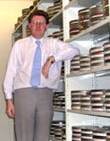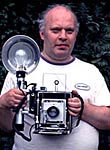|
|
This topic comprises 2 pages: 1 2
|
|
Author
|
Topic: Eastman Kodak Co.????
|
|
|
Simon Wyss
Film Handler

Posts: 80
From: Basel, BS, Switzerland
Registered: Apr 2011
|
 posted 11-22-2013 12:43 PM
posted 11-22-2013 12:43 PM




Patents, perhaps?
EKC was never in the position to even think of a possibility of attacking that market. Others have gotten hold of it before. There were the Eidoloscope with a four-to-one ratio gearing between main shaft and shutter shaft, the Kinedrome, the LeRoy-Lauste “marvellous cinematograph” with beater, the European apparatuses like what the Lumière exported, Gaumont, Continsouza-Bünzli-Pathé. Nine out of ten projectors in the 1914 USA were French.
I don’t think EKC 16-mm. projectors belong to the finest. Bell & Howell Co. made way better machines. Ampro were also among the reliable ones along with RCA and the almost unknown Diksi (1938).
EKC focused on cameras. There they had a portfolio of valuable patents, made in house. The Ciné-Kodak Special (1933) even made Paillard pause with their H camera project for more than three years. It must be admitted that the Swiss also wanted to learn about the development of the Double-Eight film format, since summer 1932. The CKS remained one of the top small-gauge cameras until the arrival of the ARRIFLEX 16 in 1952.
Eastman-Kodak wouldn’t have had the slighest chance of success in Europe against AEG, Bauer, ERKO, Ernemann, ICA, Leitz, Liesegang, Messter, Nitzsche, Zeiss-Ikon, to name only some German brands. Philips, Fedi, and Meopta come to mind, too.
Eastman-Kodak made a lot of money with film, for long years. Television caused a boost with 16-mm. film consumption in the 1950s and 1960s. DuPont made ciné films, Ansco, and Dynacolor in the US. There were a lot more film manufacturers the world over. Agfa, Agfa-Gevaert, As Graffe & Jougla, Astra, Azomureş, Barnes, Bauchet, Blair, Brifco, Carbutt, Crumière, Edwards, Eisenberg, Ferrania, Fotochema, Fotokémia, Fotokemika, Fuji, Gevaert, Glanzfilm, Gloria, Goerz, Guilleminot, Hauff, Herzog, Ilford, Indu, Kalle, Konica, KFG, Kranz, Kuibisheff, Lignose, Lumière, 3M, Mafe, Mimosa, NPG, Negra, Nobel, Northern, Oriental, Pathé, Perutz, Planchon, Rotary, Schering, Schleussner Adox, Selo, Slavitch, SMPIC, Svema, Tellko, Tientsing, Tura, Typon, Valca, Voigtländer, Wellington & Ward, Westendorp & Wehner, Wolf Walsrode. EKC was the biggest.
| IP: Logged
|
|
|
|
|
|
Leo Enticknap
Film God

Posts: 7474
From: Loma Linda, CA
Registered: Jul 2000
|
 posted 11-22-2013 10:25 PM
posted 11-22-2013 10:25 PM





Why do Shell and Exxon not make cars? Why does Microsoft not make PCs? Why don't Boeing and Airbus run their own airlines? Why doesn't McDonald's produce its own food?
I'm guessing the answer to be that big businesses work most effectively when they're focused on a single product or service, and don't try to combine all the processes of a given industry under one roof.
At the very beginning of the film industry, they did: the Lumieres in France, Hepworth and Paul in Britain, Messter in Germany and Edison in the United States all manufactured and sold hardware, and made films. But this business model ended within a decade and a half. Part of the reason (in the US) was the MPPC antitrust ruling, which effectively ruled that the companies that sold the technology also controlling film production was illegal. And of course it was to escape from the clutches of the MPPC that the moguls headed west from New York to California and turned Hollywood from a bunch of orange groves into ... well, Hollywood. And so that gulf between the companies that made the technology and the companies that made the movies now has a 90-year history behind it.
But it doesn't explain why integrating the production of technology with the production of movies using it was never really a successful business model in the first place.
16mm is arguably a bit of an exception, because the format was invented and launched by EK as an amateur filmmaking system (a widely told story is that 16mm is the width it is because George Eastman was determined that nitrate film should never get into the hands of amateurs on safety grounds: 16mm cannot be made by slitting 35mm down the middle, and so this reduced the risk of third-party resellers marketing their own 16mm stock by buying 35mm nitrate in bulk and slitting it). When it was launched in 1923, no third-party manufacturer made cameras and projectors for 16mm, and so EK had to if it was to sell. As Louis points out, EK never made consumer hardware in-house anyway: manufacturing was subcontracted out.
| IP: Logged
|
|
|
|
|
|
|
|
|
|
|
|
|
|
Simon Wyss
Film Handler

Posts: 80
From: Basel, BS, Switzerland
Registered: Apr 2011
|
 posted 11-24-2013 03:03 PM
posted 11-24-2013 03:03 PM




Split film (17.5 mm) was already used at the turn of the century. Later in WWI it was revived by Bell & Howell.
Charles Pathé and George Eastman agreed after WWI that only safety film should be given to the homes, the then giant sleeping market. In 1919 Eastman-Kodak and BH startet the 5/8" film gauge project. 16 mm became a parallel designation and took over in right only when the European players joined the game.
The Ciné-Kodak K was made by the EKC. EKC also made lenses at the Hawkeye Works they owned. The Chicago gang around Bell & Howell Co. had a deep grip on the business. It got narrowed by the loss of the professional studio camera field to the Mitchell Corp. but the reaction was well prepared. BH could actually play with many conceptual possibilities from the basic design of the motion-picture camera they had. In 1912 it was at hand, the first all-metal camera, model 2709. The Autoload, the Filmo, the Eyemo, each and every model goes back to it.
With the projectors BH first followed the general layout of both reels in front of the body, example Filmo. When it was decided to build a sound projector they rearranged the reels with one in front and one at the rear of the body, the film undergoing the lamp house. That design remained unaltered with portable 16-mm. film projectors from the first Filmosound of 1934 until today.
I always wondered why Kern of Aarau never entered the field of projection lenses for 35-mm. film.
| IP: Logged
|
|
Stephen Furley
Film God

Posts: 3059
From: Coulsdon, Croydon, England
Registered: May 2002
|
 posted 11-24-2013 03:08 PM
posted 11-24-2013 03:08 PM




There have been a number of 17.5 mm formats over the years. There were several such formats, both edge and centre perforated, within a few years of the introduction of 35 mm film. All were silent of course.
web page
The Pathe Rural format lasted long enough to gain a sound track. This was quite an interesting format, and the only 17.5 mm one which I have actually seen projected. The perforations were smaller than those on 16 mm, and fitted between the rounded corners of the frames; this enabled a considerably larger frame size than on 16 mm. If the format had lasted long enough for a modern projector to be developed for it, say a 17.5 mm Kinoton xenon machine, it should have been quite impressive.
The 17.5 mm magnetic stock which Steve K used to be readily available in London.
17.5 mm was also there in the earliest days of public broadcast television; the Baird Intermediate Film system, briefly used by the BBC in 1936, used a film of this gauge.
| IP: Logged
|
|
|
|
Leo Enticknap
Film God

Posts: 7474
From: Loma Linda, CA
Registered: Jul 2000
|
 posted 11-24-2013 09:28 PM
posted 11-24-2013 09:28 PM





There's an interesting postscript to the 17.5mm story. By the outbreak of WWII, it was in relatively widespread use (under the 'Pathé-Rural' badge, as Stephen notes) in France, but pretty much nowhere else. As a result, anti-Nazi propaganda films began to be distributed on the format when the French film industry came under occupation (as a sidebar, Henri-Georges 'The Wages of Fear' Clouzot's refusal to participate in resistance-related filmmaking was part of the reason for him being ostracised from the French film industry in the aftermath of the war, and being accused of pro-Nazi sympathies by some to this day), in response to which the German occupying forces were given orders to remove every projector and other 17.5mm-related piece of hardware they could find out of circulation and destroy it.
There are snippets of information and references to this in various history books dealing with French and German cinema during the war, but AFAIK no-one has yet researched and written up the whole story. Doing this would probably need some hard core research in the Cinémathèque Française, the Bundesarchiv and the Berlin film museum, and neither my language skills nor the location of my new home make this a really viable project for me; but I'm hoping that a Europe-based historian will do it at some point.
The same thing happened in reverse in China in the '70s with the 8.75mm gauge. The French Resistance used a non-standard format in an attempt to screen material that the authorities would not allow: in China, the authorities themselves used a non-standard format, software production for which they controlled completely, in order to prevent their citizens from viewing unauthorised material.
| IP: Logged
|
|
|
|
All times are Central (GMT -6:00)
|
This topic comprises 2 pages: 1 2
|
Powered by Infopop Corporation
UBB.classicTM
6.3.1.2
The Film-Tech Forums are designed for various members related to the cinema industry to express their opinions, viewpoints and testimonials on various products, services and events based upon speculation, personal knowledge and factual information through use, therefore all views represented here allow no liability upon the publishers of this web site and the owners of said views assume no liability for any ill will resulting from these postings. The posts made here are for educational as well as entertainment purposes and as such anyone viewing this portion of the website must accept these views as statements of the author of that opinion
and agrees to release the authors from any and all liability.
|

 Home
Home
 Products
Products
 Store
Store
 Forum
Forum
 Warehouse
Warehouse
 Contact Us
Contact Us




 Printer-friendly view of this topic
Printer-friendly view of this topic















